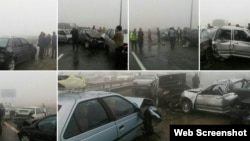At least 76 people were killed in car accidents in the first three days of the Iranian New Year and 126 in preceding days.
According to highway patrol deputy chief Mousa Amiri, car accidents left 16 people dead and 467 injured on March 22, the second day of the Iranian New Year (March 22).
Overturned cars, which made up 40 percent of car accidents, topped the list of lethal crashes.
The parliamentary Research Center reported that traffic-related accidents cost the country $7 billion to $11 billion annually.
Estimates vary about total number of road fatalities in Iran, but the by all accounts it is much higher than the world average.
According to WHO’s 2013 statistics, the average number of road accident deaths in the world is 17 per 100,000 inhabitants. Iran’s average for the same year is 32 per 100,000, which is close to the highest accident death rate in the world.
Official estimates by the Roads and Transportation Ministry show that around 25,000 people are killed and about 250,000 injured in car accidents in Iran each year. It is also estimated that car accidents claim three lives per hour in Iran.
Based on a World Health Organization (WHO) 2014 report, 9.52 percent of total deaths in Iran involved car accidents and reached more than 32,000 per year.
The two-week break for Norooz (ending April 2 in the Iranian new year) typically witnesses the year’s deadliest car crashes across the country.
It is estimated that overall more than half a million have been killed in car crashes in the past two decades.
The statistics are so horrific that even the clergy have stepped in to encourage people to drive safely.
“Violating traffic laws is a sin, and following these rules is a religious duty,” asserted one of the officially recognized grand ayatollahs, Nasser Makarem Shirazi.
He had earlier reiterated, “Driving when tired, illegally passing other cars, and running red lights are haram (forbidden).”
Substandard roads, older cars, lack of proper training, inadequate law enforcement, and driver sleepiness are the major reasons for traffic accidents in Iran.
Roads, particularly in mountainous regions, are old and poorly maintained.
A report jointly compiled by UNICEF in tandem with Iran’s Health Ministry, the State Welfare Organisation, police, and the Municipality of Tehran said that every 19 minutes someone dies on Iran’s roads, and every two minutes a family hears that a relative has survived a crash but with serious injury and perhaps lifelong disability.
Traffic fatalities cost Iran’s economy $6 billion every year, which amounts to more than 5 percent of the country’s gross national product.
Some 25 percent of all road fatalities in Iran involve motorcycles, and more than 60 percent of those occur because drivers are not wearing a helmet.





